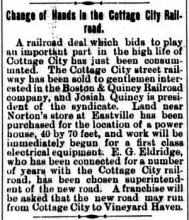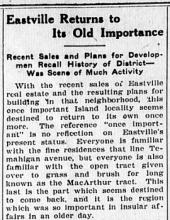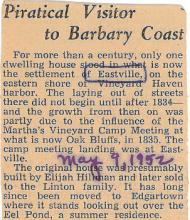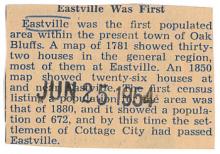With the recent sales of Eastville real estate and the resulting plans for building in that neighborhood, this once important Island locality seems destined to return to its own once more. The reference “once important” is no reflection on Eastville’s present status. Everyone is familiar with the fine residences that line Temahigan avenue, but everyone is also familiar with the open tract given over to grass and brush for long known as the MacArthur tract. This last is the part which seems destined to come back, and it is the region which was so important in insular affairs in an older day.
There are many persons, not so very old, who can remember when there was no road whatever where Temahegan avenue now extends its finely surfaced reach. There was nothing but a continuation of the sloping grassland there. But the road that passes by the present Eastville Inn has been in existence for many generations. Traces of tar macadam show that it once extended to the water’s edge, and this is a fact, for it was and still is a public road, designated as “county road” and extending through what is now Oak Bluffs to Edgartown.
At the top of the rise stood the tavern as long ago as 1800 or thereabouts, and probably long before that, for the landing at the foot of the road was the principal one outside of Edgartown and there is no doubt but that passengers were landed there when weather conditions made it impracticable to proceed to the Island seaport.
Wharf at Foot of County Road
In later years, well remembered by many, New York avenue extended as it does at the present time, but without the connecting highway to the Old County Road. The wharf stood at the foot of the latter road, and was used by freighting vessels of all kinds, and by passenger steamers. This was the landing place of the Eastern Steamship company, which made regular stops there. The remains of a set of platform scales in the beach grass still mark the site of a coal yard and it is recalled, too, that there was a boat railway there. The power house for the old trolley line was close by.
There was a store, handling ship stores and marine hardware, and another store of sorts in the old MacArthur house, selling home cooked food principally, to sailors who came ashore at that point.
At that time the swampy pond in the center of the tract was quite a respectable lake, large enough for row boats. A treacherous piece of water, according to all accounts, with a mud bottom that appeared fathomless and often sucked down oars used by the unwary to push with.
Still later, when the drawbridge had become a permanent institution and much of Eastville’s business had been removed to Vineyard Haven, the old house was used for sheltering boys of the Treat school. The restoration of this house, which is now under way, marks the first step in bringing back the life that once was Eastville’s.
The old house is worthy of note, with its suggestion of comfort and the spaciousness of its old rooms. Fireplaces and paneling, cupboards and closets, in odd and out-of-the-way places, and the splendid view of the water from its many windows.
It has seen strange sights and interesting ones, this house, or possibly a previous building, for the materials from a much older building were used in its construction. Old, old mortices and the remains of pins can be seen today in the sills.
Past this place walked Capt. James Lawrence, hero of the Chesapeake. Past here, also, strode John Paul Jones, if tradition may be believed, on his way to the inn where he recruited men for the crew of the Bon Homme Richard. And many another seafarer, not so honorable, in those days when gentlemen of fortune sometimes sailed this way.
And now life is to return to this corner from which it disappeared so long ago and so completely. It will be a new form of life, new faces and new ambitions, but it will be the same old Eastville that contributed so important a part to the development of other parts of the Vineyard.










Comments